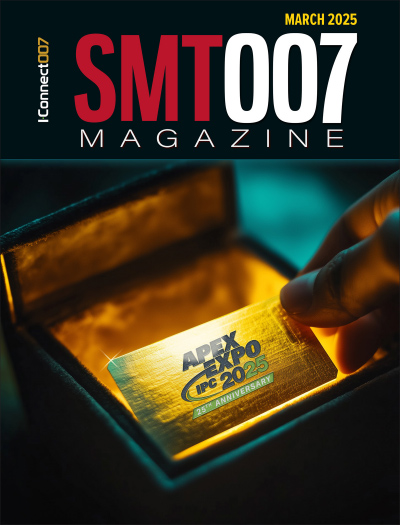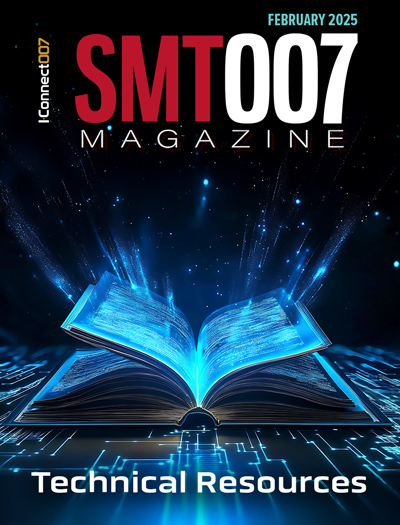-

-
News
News Highlights
- Books
Featured Books
- smt007 Magazine
Latest Issues
Current Issue
IPC APEX EXPO 2025: A Preview
It’s that time again. If you’re going to Anaheim for IPC APEX EXPO 2025, we’ll see you there. In the meantime, consider this issue of SMT007 Magazine to be your golden ticket to planning the show.

Technical Resources
Key industry organizations–all with knowledge sharing as a part of their mission–share their technical repositories in this issue of SMT007 Magazine. Where can you find information critical to your work? Odds are, right here.

The Path Ahead
What are you paying the most attention to as we enter 2025? Find out what we learned when we asked that question. Join us as we explore five main themes in the new year.
- Articles
- Columns
Search Console
- Links
- Media kit
||| MENU - smt007 Magazine
Reassessing Surface Finish Performance for Next-gen Technology, Part 1
June 26, 2023 | Frank Xu, PhD and Martin Bunce of MacDermid Alpha, and John Coonrod of Rogers Corp.Estimated reading time: 1 minute
Introduction
Over the years, various surface finishes have been successfully utilized, namely organic solderability preservative (OSP), immersion silver (ImAg), immersion tin (ImSn), electroless nickel immersion gold (ENIG), and electroless nickel electroless palladium immersion gold (ENEPIG), as solderable finishes for PCB and package substrates. All these surface finishes have their pros and cons, with no single finish being suited to all applications.
As system designers continue to respond to new performance demands, it can be noted that ENIG/ENEPIG finishes have endured as a leading choice in many advanced applications where reliability is prioritized over cost.
Electroless nickel (EN) deposits have served well as a barrier layer, preventing copper migration to the outer gold or palladium-gold surfaces, and enabling the robust solderability performance of ENIG and ENEPIG finishes. However, the introduction of the 5G mobile network creates a growing demand for smartphones, networking, and wireless connections, all requiring increased “data flow.” The need to reduce the signal loss at higher frequency bandwidth is becoming vitally important. The low conductivity and magnetic properties of EN affect electrical signals as they travel along a conductor’s outer surfaces leading to insertion losses at higher frequencies.
As a result, designers and fabricators are looking for newer-generation surface finishes to meet their performance criteria. EPIG (electroless palladium immersion gold with no EN), silver-gold (Ag-Au), and reducing the EN thickness from traditional ENEPIG, have all gained attention. What follows is a review that compares the performance attributes of the leading candidates for a high-frequency alternative surface finish.
MacDermid Alpha Electronic Solutions has worked in partnership with Rogers Corporation to evaluate the effect of various surface finishes on signal loss with increasing frequency. Together, we subsequently worked to understand and compare other critical-to-quality performance metrics that will guide application-based surface finish selection.
Work Program
We first set out to evaluate the effect of surface finish on signal losses up to 110 GHz using the microstrip test method and a vector network analyzer, with the support of Rogers.
To read this entire article, which appeared in the June 2023 issue of Design007 Magazine, click here.
Suggested Items
ICT Spring Seminar: Nickel Not Welcome Here
03/12/2025 | Pete Starkey, I-Connect007After a miserable, dull, and damp English winter, a really pleasant nearly spring day with the sun shining and daffodils in bloom greeted delegates to the Institute of Circuit Technology Spring Seminar at Puckrup Hall near Tewkesbury, March 5, in Gloucestershire, UK.
Multicircuits Expands Capabilities with State-of-the-Art Automated Copper Via Fill Process
03/10/2025 | MulticircuitsMike Thiel, president of Multicircuits, a leading provider of high-reliability printed circuit boards, has announced the addition of a state-of-the-art automated copper via fill process to their advanced manufacturing capabilities. This strategic investment enhances the company’s ability to deliver cutting-edge solutions for demanding industries, including aerospace, defense, medical, and high-speed telecommunications.
EIPC 2025 Winter Conference, Day 2: A Roadmap to Material Selection
02/20/2025 | Pete Starkey, I-Connect007The EIPC 2025 Winter Conference, Feb. 4-5, in Luxembourg City, featured keynotes and two days of conference proceedings. The keynote session and first-day conference proceedings are reported separately. Here is my review of the second day’s conference proceedings. Delegates dutifully assembled bright and early, well-rested and eager to participate in the second day’s proceedings of the EIPC Winter Conference in Luxembourg.
Designers Notebook: Addressing Future Challenges for Designers
02/06/2025 | Vern Solberg -- Column: Designer's NotebookThe printed circuit board is and will probably continue to be the base platform for most electronics. With the proliferation of new generations of high I/O, fine-pitch surface mount semiconductor package variations, circuit interconnect is an insignificant factor. Circuit board designers continually face challenges such as component quantity and complexity, limited surface area, and meeting the circuit board’s cost target. The printed circuit design engineer’s prominent position demands the development of efficiently manufacturable products that perform without compromise.
DesignCon 2025, Day 2: It’s All About AI
01/30/2025 | Marcy LaRont, I-Connect007It’s hard to get away from the topic of artificial intelligence, but why would you? It’s everywhere and in everything, and my time attending presentations about AI at DesignCon 2025 was well worth it. The conference’s agenda featured engaging presentations and discussions focused on the technological advancements in AI, big data centers, and memory innovations, emphasizing the critical relationship between processors and circuit boards.


